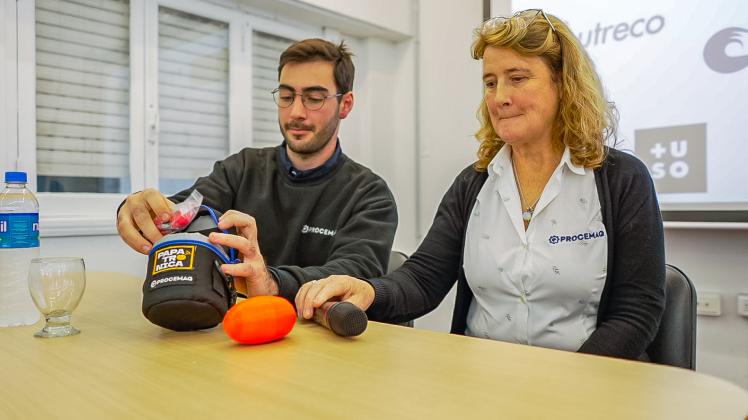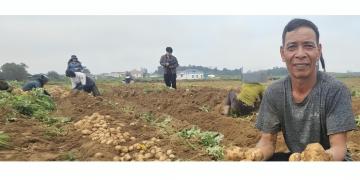Innovations: Papatronics, the technological innovation that seeks to curb losses in the field
According to data from the Food and Agriculture Organization of the United Nations (FAO), up to 35% of fruits and vegetables produced globally are lost before reaching the table.

And although this loss is often attributed to domestic consumption, the reality is that much of the waste occurs long before: during harvesting, transportation, sorting, and storage. During this silent journey, every blow a product receives can mark its fate as discarded food.
Luciano Velázquez, a professor and researcher at the Faculty of Agricultural Sciences at the National University of Mar del Plata, is well acquainted with the problem. From the integrated unit shared by UNMDP and INTA in Balcarce, he led an unprecedented development: an open-source electronic device that allows you to know where, when, and how potatoes are hit during the production process. The invention, called Papatrónica, was born with a clear intention: measure in order to reduce.
“We’re developing a tool that allows us to identify when a potato is damaged during harvest or post-harvest. Because a damaged potato, even if it appears healthy, rots more quickly. And that rot can ruin not only that potato, but many others in its surroundings,” Velázquez explained.
A device disguised as a real popeThe Papatronic has the average shape, size, and weight of a real potato, specifically the Innovator variety, used by the industry to make chips and French fries. But it’s not edible. Its casing was 3D-printed and painted fluorescent orange to make it easily visible among the real tubers.
"Many producers didn’t use measuring devices because they got lost in the field. That’s why we decided to give it a striking color. It also has a tracking system that allows it to be located if it goes missing," the researcher explained.
Inside, the Papatronics system houses sensors that record impacts in real time. Through a mobile app developed in collaboration with Eric’s, the data is wirelessly sent to the operator’s device. This allows them to know exactly how many impacts the target potato received, in which sections of the harvester, conveyor belt, or truck they occurred, and with what intensity.
Velázquez explained that the industrial harvesting process can involve falls of up to two meters from the harvester to the truck. “We measure the intensity of the impacts using G-forces. A light blow reaches around 50 G, which is the same magnitude a Formula 1 racer endured in a crash in Las Vegas. And that, for a potato, can be lethal.”
The immediate consequence is an internal injury that, even if not visible, triggers decomposition processes. A damaged potato is an open door for bacteria and fungi. In storage chambers where up to 2,000 tons accumulate, an infection can cause the loss of half the batch. "We’re talking about food that could feed thousands of people, and it rots because of a fall that could have been avoided," Velázquez insisted.
Open science and regional cooperationThe development was made possible through collaborative efforts between the Faculty of Agricultural Sciences, INTA Balcarce, the University Center for Citizen Innovation (CUIC) of the Faculty of Exact Sciences of UNICEN, CONICET researchers, and the software company Eric’s. In a second phase, Procemac, a local company in Balcarce, joined the team and promoted the commercial version of the device.
"The first prototype was open source and is still available for anyone who wants to adapt it. We believe in the philosophy of free software and hardware, because the important thing is that this tool is used, improved, and replicated," said Velázquez.
The device is currently being marketed through an agreement between the UNMDP and Procemac. Companies such as McCain and Lam Weston already use it in their production lots. Although the exact number of units sold was not disclosed, maps show that its use has spread throughout the southeastern region of Buenos Aires province, the country’s main potato-producing area.
Less losses, more sustainabilityPapatronics not only helps preserve product quality and increase production efficiency, it also represents a concrete step toward food sustainability. According to the researcher, in many cases, industries have managed to reduce mechanical damage to potatoes by up to 50% thanks to the device.
In addition to its economic impact, innovation contributes to reducing food waste, a key objective for ensuring global food security. “It’s not just about saving money. It’s about not throwing away food that was hard to produce, that required land, water, and labor. That has enormous environmental and social value,” Velázquez emphasized.
How much does a Papatronics cost?The question many producers ask has a relative answer. Although the exact price varies, it’s estimated to be around $1,500, depending on the type of components used—mostly imported—and the integrated features. Velázquez was emphatic: "The price is insignificant compared to the profit it generates. A single Papatronic can cover dozens of batches and avoid millions in losses."
The mobile app is now available on Google Play under the name "Papatrónica." The device can be purchased by contacting Procemac, the company that manufactures and distributes it in conjunction with UNMDP.
The team is already thinking about adapting the technology to other productions. "The principle is the same. If we develop a ’batatrónica’ or a ’manzanatrónica’, we could bring this system to the Río Negro Valley, in the north of the country, or even export it," Velázquez said.
The goal, he stated, is not only to generate marketable technology, but also to sustain a university development model that links research with production and adds value to local communities.
“Research isn’t an expense, it’s an investment. This is a clear example: Papatronics not only generates income for the university and faculty, but also solves a real problem. And it’s just the first of many innovations we will continue to develop.”
Fuente:




